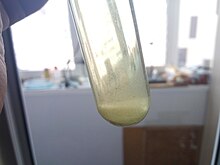Our website is made possible by displaying online advertisements to our visitors.
Please consider supporting us by disabling your ad blocker.
Iodoform
 | |||
| |||
 | |||
| Names | |||
|---|---|---|---|
| Preferred IUPAC name
Triiodomethane | |||
| Other names | |||
| Identifiers | |||
3D model (JSmol)
|
|||
| 1697010 | |||
| ChEBI | |||
| ChEMBL | |||
| ChemSpider | |||
| ECHA InfoCard | 100.000.795 | ||
| EC Number |
| ||
| KEGG | |||
| MeSH | iodoform | ||
PubChem CID
|
|||
| RTECS number |
| ||
| UNII | |||
CompTox Dashboard (EPA)
|
|||
| |||
| |||
| Properties | |||
| CHI3 | |||
| Molar mass | 393.732 g·mol−1 | ||
| Appearance | Pale, light yellow, opaque crystals | ||
| Odor | Saffron-like[3] | ||
| Density | 4.008 g/cm3[3] | ||
| Melting point | 119 °C (246 °F; 392 K)[3] | ||
| Boiling point | 218 °C (424 °F; 491 K)[3] | ||
| 100 mg/L[3] | |||
| Solubility in diethyl ether | 136 g/L | ||
| Solubility in acetone | 120 g/L | ||
| Solubility in ethanol | 78 g/L | ||
| log P | 3.118 | ||
Henry's law
constant (kH) |
3.4 μmol·Pa−1·kg−1 | ||
| −117.1·10−6 cm3/mol | |||
| Structure | |||
| Hexagonal | |||
| Tetrahedral at C | |||
| Thermochemistry | |||
Heat capacity (C)
|
157.5 J/(K·mol) | ||
Std enthalpy of
formation (ΔfH⦵298) |
180.1 – 182.1 kJ/mol | ||
Std enthalpy of
combustion (ΔcH⦵298) |
−716.9 – −718.1 kJ/mol | ||
| Pharmacology | |||
| D09AA13 (WHO) | |||
| Hazards | |||
| GHS labelling: | |||

| |||
| Warning | |||
| H315, H319, H335 | |||
| P261, P280, P305+P351+P338 | |||
| NFPA 704 (fire diamond) | |||
| Flash point | 204 °C (399 °F; 477 K) | ||
| Lethal dose or concentration (LD, LC): | |||
LD50 (median dose)
|
|||
| NIOSH (US health exposure limits): | |||
PEL (Permissible)
|
none[4] | ||
REL (Recommended)
|
0.6 ppm (10 mg/m3)[4] | ||
IDLH (Immediate danger)
|
N.D.[4] | ||
| Related compounds | |||
Related compounds
|
|||
Except where otherwise noted, data are given for materials in their standard state (at 25 °C [77 °F], 100 kPa).
| |||

Iodoform (also known as triiodomethane) is the organoiodine compound with the chemical formula CHI3. It is a pale yellow, crystalline, volatile substance, with a penetrating and distinctive odor (in older chemistry texts, the smell is sometimes referred to as that of hospitals, where the compound is still commonly used) and, analogous to chloroform, sweetish taste. It is occasionally used as a disinfectant.
- ^ "Front Matter". Nomenclature of Organic Chemistry: IUPAC Recommendations and Preferred Names 2013 (Blue Book). Cambridge: The Royal Society of Chemistry. 2014. p. 661. doi:10.1039/9781849733069-FP001. ISBN 978-0-85404-182-4.
The retained names 'bromoform' for HCBr3, 'chloroform' for HCCl3, and 'iodoform' for HCI3 are acceptable in general nomenclature. Preferred IUPAC names are substitutive names.
- ^ "Iodoform".
- ^ a b c d e f g Record in the GESTIS Substance Database of the Institute for Occupational Safety and Health
- ^ a b c NIOSH Pocket Guide to Chemical Hazards. "#0343". National Institute for Occupational Safety and Health (NIOSH).
- ^ Merck Index, 12 Edition, 5054
Previous Page Next Page





